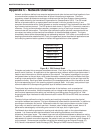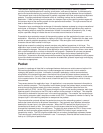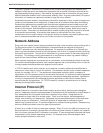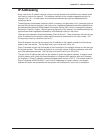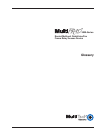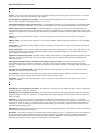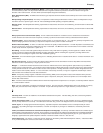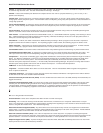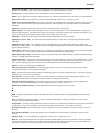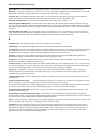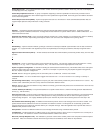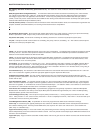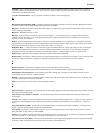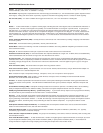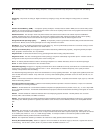
84
MultiFRAD 3000-Series User Guide
Centrex: A multi-line service offered by operating telcos which provides, from the telco CO, functions and features comparable to those
of a PBX for large business users. See also "Private Branch Exchange", "Exchange".
Channel: A data communications path between two computer devices. Can refer to a physical medium (e.g., UTP or coax), or to a
specific carrier frequency.
Channel bank: A device that acts as a converter, taking the digital signal from the T1 line into a phone system and converting it to the
analog signals used by the phone system. A channel bank acts as a multiplexer, placing many slow-speed voice or data transactions on
a single high-speed link.
Circuit-switched Network: A technology used by the PSTN that allocates a pair of conductors for the exclusive use of one communica-
tion path. Circuit switching allows multiple conversations on one talk path only if the end-users multiplex the signals prior to transmis-
sion.
Circuit switching: The temporary connection of two or more communications channels using a fixed, non-shareable path through the
network. Users have full use of the circuit until the connection is terminated.
Clear Channel: A transmission path where the full bandwidth is used (i.e., no bandwidth needed for signaling, carrier framing or control
bits). A 64K bps digital circuit usually has 8K bps used for signaling. ISDN has two 64K bps circuits, and a 16K bps packet service of
which part is used for signaling on the 64K channels.
Client-Server: In TCP/IP, the model of interaction in distributed data processing in which a program at one site sends a request to a
program at another site and awaits a response. The requesting program is called a client; the answering program is called a server.
Cluster Controller: A device that can control the input/output operations of more than one device connected to it. A cluster controller
may be controlled by a program stored and executed in the unit, or it may be entirely controlled by hardware.
Committed Burst Size: the maximum number of bits that the frame relay network agrees to transfer during any measurement interval
Committed Information Rate (CIR): An agreement a customer makes to use a certain minimum data transmission rate (in bps). The
CIR is part of the frame relay service monthly billing, along with actual usage, that users pay to their frame relay service provider.
Compression: 1. The process of eliminating gaps, empty fields, redundancies, and unnecessary data to shorten the length of records or
blocks. 2. In SNA, the replacement of a string of up to 64-repeated characters by an encoded control byte to reduce the length of the
data stream to the LU-LU session partner. The encoded control byte is followed by the character that was repeated (unless that
character is the prime compression character). 3. In Data Facility Hierarchical Storage Manager, the process of moving data instead of
allocated space during migration and recall in order to release unused space. 4. Contrast with decompression.
COMx Port: A serial communications port on a PC.
congestion: A network condition where there is too much data traffic. The ITU I.233 standard defines congestion management in
terms of speed and burstiness.
congestion notification: The function in frame relay that ensures that userdata transmitted at a rate higher than the CIR are allowed
to slow down to the rate of the available network bandwidth.
Consecutive Severely Errored Seconds (CSES): An error condition that occurs when from 3 to 9 SES (Severely Errored Seconds) are
logged consecutively.
Customer Premise Equipment (CPE): The generic term for data comm and/or terminal equipment that resides at the user site and is
owned by the user with the following exclusions: Over voltage protection equipment, inside wiring, coin operated or pay telephones,
"company-official" equipment, mobile telephone equipment, "911" equipment, equipment necessary for the provision of communications
for national defense, or multiplexing equipment used to deliver multiple channels to the customer.
D
D4: the T1 4th generation channel bank.
D4 channelization: Refers to the compliance with AT&T TR 62411 for DS1 frame layout.
D4 framing: The T1 format for framing in AT&T D-Series channel banks, in which there are 12 separate 193-bit frames in a super-
frame. A D4 framing bit is used to identify the channel and the signaling frame. Signalling for voice channels is carried in-band for every
channel, along with the encoded voice. See "robbed-bit signaling".
Data Communications Equipment (DCE): Any device which serves as the portal of entry from the user equipment to a telecommuni-
cations facility. A modem is a DCE for the telephone network (PSTN) that is commonly on site at the user’s premises. Packet Switched
Networks have another level of DCE which is most often located at a central office.
Data Link Connection Identifier (DLCI): One of the six components of a frame relay frame. Its purpose is to distinguish separate
virtual circuits across each access connection. Data coming into a frame relay node is thus allowed to be sent across the interface to the
specified "address". The DLCI is confirmed and relayed to its destination, or if the specification is in error, the frame is discarded.
Dataphone Digital Service (DDS): A private line digital service that offers 2400, 4800, 9600 and 56K bps data rates on an inter-LATA
basis by AT&T and on an intra-LATA basis by the BOCs.



